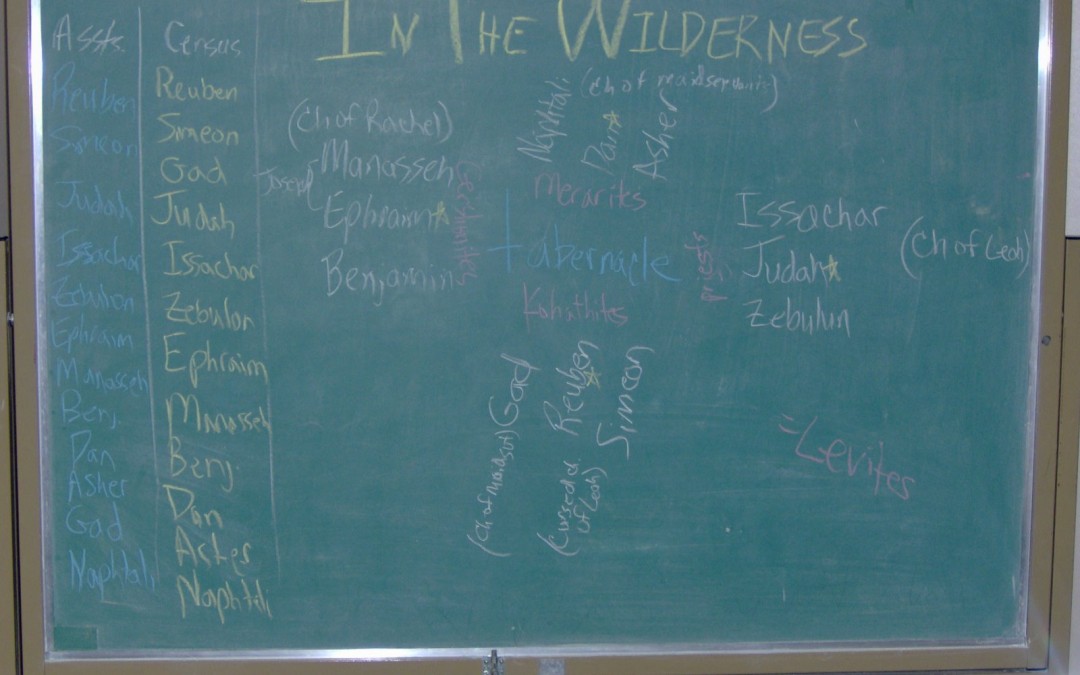
Exodus, Leviticus and Numbers are tied together because the Israelites arrived at Sinai with Exo 19:1 and began their journey from Sinai with Num 10:11. Thus the beginning of Numbers is meant to be read as a continuation of the story of Exodus and Leviticus. The reason for the title Numbers sticking is the census taking in the book. However, the Hebrew title, “In the wilderness [desert]” is more appropriate because the people begin the book in the desert and end the book in the desert. In Deuteronomy too, they are not yet in the land at the end. Therefore, the story of the Torah (Old Testament Gospels) in an of itself is incomplete and needs the Prophets (Old Testament Acts) just as the Gospels (New Testament Torah) awaited the giving of the Spirit in Acts (New Testament Prophets).
“In the Wilderness” is an Old Testament Gospel teaching “that the Christ should suffer and on the third day rise from the dead, and that repentance and forgiveness of sins should be proclaimed in his name to all nations, beginning from Jerusalem” and promising the Spirit on the Pentecost after Jesus’ resurrection (Luke 24:46-49). The book tells us about two generations of Israel. The first characterized by unbelief and the second by faith. This section is the necessary background we need for the first generation.
The book begins with the setting “in the wilderness of Sinai” and “in the tent of meeting” and with the timing of day one, month two, year two after leaving Egypt (Num 1:1). You may remember that the calendar begins with the Exodus event. So this is two years and one full month later. But the timing of the Passover celebration recorded later, also “in the wilderness of Sinai” is day fourteen, month one, year two after leaving Egypt (Num 9:1-5). Fourteen is seven times two. But the point is that Num 9 takes place before Num 1, chronologically speaking.
The section starts well. The people stood up to be counted for holy war (Num 1:3). Those numbered were men twenty years old and up able to go to war. A man was called from each tribe to help. There are twelve tribes (this does not include the tribe of Levi, but does include both children of Joseph so that you still get twelve). Reuben had 46,500 (Num 1:21), Simeon had 59,300 (Num 1:23), Gad had 45,650 (Num 1:25), Judah had 74,600 (Num 1:27), Issachar had 54,400 (Num 1:29), Zebulun 57,400 (Num 1:31), Ephraim 40,500 (Num 1:33), Manasseh 32,200 (Num 1:35), Benjamin 35,400 (Num 1:37), Dan 62,700 (Num 1:39), Asher 41,500 (Num 1:41), Naphtali 53,400 (Num 1:43), plus the twelve who helped totals 603,550 (Num 1:46). The census follows a clear narrative pattern making it somewhat repetitious. It should not be surprising that Judah is most populous and even adding the two sons of Joseph together comes just short of Judah.
The order of the tribes in Num 1 is strange on first reading. Both the list of assistants and each tribe’s census follows the same order except for Gad. The assistant’s order of Dan, Asher, Gad, Naphtali is odd because they are not grouped by their mother or birth-order. The assistant’s order follows their natural ranking among the sons of Jacob but the random order of these last four is another way of indicating their lesser status. In the census order itself, the movement of Gad to follow Reuben and Simeon prepares us for what will follow next (all as Iain Duguid observes in his commentary, p.41).
The second chapter shows the tabernacle at the center and the tribes arranged around it. Thus the tent of the King in the Ancient Near East is at the center (in other words, God is king). We mentioned this previously in the post about the tabernacle as heaven on earth on Exodus 25-31 and 35-40. But here we can add this observation Duguid makes: east of the tabernacle are the children of Leah (Issachar, Judah, and Zebulun), south of the tabernacle are the child of maidservants (Gad) and cursed children (Reuben and Simeon), west of the tabernacle are the children of Rachel (Manasseh, Ephraim, and Benjamin), and north of the tabernacle are the children of maidservants (Naphtali, Dan, and Asher). Thus there are three tribes on each side with the one in the middle leading that section.
Duguid also notes that the Levites are also arranged around the tabernacle with the priests on the east, the Kohathites carrying the most holy things on the south even though Kohath was Gershon’s younger brother, the Gershonites carrying the holy things on the west, and the Merarites carrying the least holy things on the north. This arrangement is helpful for understanding later scenes like Num 16.
Duguid says, “Both elements that define the church — the boundary and the center — are important” (p.37). He calls the people of God “an edge-bounded group” who stand up to be counted (church membership) and “a center-focused group” who keep God at the center. Both ideas need to be held together: “your God will be my God and your people will be my people.” Ultimately, Jesus is the boundary and the center — that is, we are in Christ (boundary) and Jesus is Lord (center).
A genealogy of the sons of Aaron follows in the third chapter even reminding us of the fire incident (Num 3:4). The Levites belonged to God in place of the firstborn of each household (Num 3:12-13). They had guard duty with regard to the sanctuary and its furnishings but not military duty and so they were not counted in the census but they are numbered for this duty. Their guard duty included living between the people and the tabernacle to guard the people from it. There were 22,000 Levite males a month old and up (Lev 3:39) and there were 22,273 firstborn males in Israel (Num 3:43). Therefore, the other 273 had to be redeemed (Num 3:46ff). The Levitical sons of Kohath were then numbered in a census from age 30-50 (Num 4:2-3). These things were to prepare them to move the sanctuary on the journey. The same was done for the Levitical sons of Gershon (Num 4:22-23) and Merari (Num 4:29-30) for the same purpose.
Numbers 5 gives us some legal case studies in a narrative framework. First, they are to put the unclean outside the camp. Second, if they “break faith” they are to confess their sin and make restitution. And the third case is a special ordeal trial with water of bitterness for women suspected of adultery. Duguid classifies these cases as “sin as defilement,” “sin as transgression,” and “sin as unfaithfulness.” And points the reader to Jesus as the solution to each.
Numbers 6 relates to us the Nazirite Vow. Duguid describes Nazirites as “a kind of temporary lay priest” (p.79). The Nazirites were set apart to YHWH by being set apart from alcohol and grapes, haircuts, and dead bodies (even immediate family). They are to be a microcosm of Israel, the kingdom of priests. The steps for cleansing are also mentioned should someone die suddenly in his presence and the steps for his offerings when the vow is complete are also described. And the Aaronic blessing is given, “YHWH bless you and keep you; YHWH make his face to shine upon you and be gracious to you; YHWH lift up his countenance upon you and give you peace” (Num 6:24-26). This was the blessing for the people of God.
Numbers 7 tells us about the twelve days of offerings in thanksgiving for the consecration of the tabernacle. The order of these offerings was from Judah, Issachar, Zebulon, Reuben, Simeon, Gad, Ephraim, Manasseh, Benjamin, Dan, Asher, and Naphtali. We can observe that they went in order from east, south, west, and north and by priority (thus Simeon before Gad and Manasseh before Benjamin, etc.) Afterwards an offering to set apart the Levites as the firstborn was given.
The whole section is set apart not only by location but also by the concluding phrase: “I am YHWH your God” (Num 10:10), a fitting way to end given its structural significance to ending paragraphs and other sections in the book of Leviticus.

Recent Comments